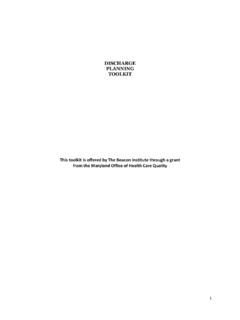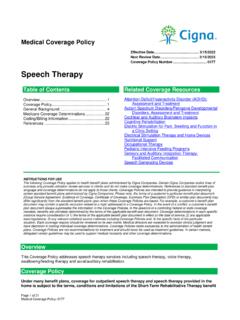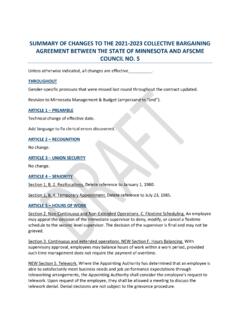Transcription of Hospital-wide- (All-condition) 30‐Day Readmission Measure
1 Hospital-Wide (All-Condition) 30 Day Risk-Standardized Readmission Measure DRAFT Measure Methodology Report Submitted By Yale New Haven Health Services Corporation/Center for Outcomes Research & Evaluation (YNHHSC/CORE): Leora Horwitz, MD, MHS. Chohreh Partovian, MD, PhD. Zhenqiu Lin, PhD. Jeph Herrin, PhD. Jacqueline Grady, MS. Mitchell Conover, BA. Julia Montague, MPH. Chloe Dillaway, BA. Kathleen Bartczak, BA. Joseph Ross, MD. Susannah Bernheim, MD, MHS. Elizabeth Drye, MD, SM. Harlan M. Krumholz, MD, SM. Contract number: HHSM-500-2008-0025I/HHSM-500-T0001, Modification No. 000005. Prepared For: Centers for Medicare & Medicaid Services (CMS). Last updated August 10, 2011. DRAFT 1. TABLE OF CONTENTS. LIST OF 4. LIST OF FIGURES .. 5. GLOSSARY OF TERMS .. 6. 1. INTRODUCTION .. 7. Overview of Measure .. 7. Hospital-wide Readmission as a Quality Indicator .. 7. Approach to Measure Development .. 8. 2. 9. Overview .. 9. Outcome Definition .. 10. Planned readmissions .. 10. Thirty-day timeframe.
2 14. All-cause Readmission .. 17. Definition of Eligible Population .. 17. Grouping patients into clinically coherent discharge condition categories by using AHRQ Clinical Classification System (AHRQ-CCS) .. 17. Inclusion / exclusion criteria .. 18. Administrative Model Development .. 20. Data sources .. 20. Multiple models .. 22. Models are defined by care team (service line) or clinical coherence .. 22. Risk Adjustment .. 24. Complications of hospitalization .. 24. Case mix adjustment: risk variables .. 25. Service mix adjustment .. 26. Statistical Approach to Model Development .. 26. Models for each cohort of conditions .. 26. Hospital performance reporting .. 28. Creating interval estimates .. 28. Algorithm .. 28. 3. RESULTS .. 30. 4. summary .. 32. DRAFT 2. 5. REFERENCES .. 33. 6. APPENDIX TABLES .. 36. Appendix A Top 10 primary discharge diagnoses for planned procedures .. 36. Appendix B List of AHRQ procedure CCs defining the surgical/gynecological 45. Appendix C Condition categories assigned to the medical cohorts.
3 48. Appendix D Conditions that are treated as complications if occurring during index 54. Appendix E Candidate risk variables .. 56. Appendix F Final risk-adjustment variables .. 57. DRAFT 3. LIST OF TABLES. Table 1 Planned procedure list .. 12. Table 2 discharge condition categories considered acute or complications of 13. Table 3 Admissions, readmissions and mortality for the seven cohorts (2008) .. 24. Table 4 Frequency of hospitals in each cohort (Number of hospitals = 4919) .. 31. Table 5 Number of hospitals based on number of models to which they contribute .. 31. Table 6 C-statistic for each model .. 31. DRAFT 4. LIST OF FIGURES. Figure 1 Graphical representation of time to Readmission .. 15. Figure 2 Inclusion and exclusion criteria* .. 21. Figure 3 Distribution of 30-day hospital-wide Readmission rates .. 30. Figure 3a Unadjusted rate .. 30. Figure 3b Risk-standardized rate .. 30. DRAFT 5. GLOSSARY OF TERMS. Term Definition Any eligible admission to an acute care hospital assessed in Index admission the Measure for the outcome (readmitted or not within 30.)
4 Days). (See Section ). An admission to an acute care hospital within 30 days of Readmission discharge from an acute care hospital. (See Section ). A. Readmission may in turn serve as an index admission. An intentional Readmission within 30 days of discharge from an acute care hospital that is a scheduled part of the patient's plan Planned Readmission of care. Planned readmissions are not counted as outcomes in this Measure (see Section ). discharge diagnosis ICD-9 level code of the principal reason for hospitalization. A group of related discharge diagnosis ICD-9 codes, as discharge condition grouped by the Agency for Healthcare Research and Quality category (AHRQ) Clinical Classification Software (CCS). (See Section ). A group of admissions for patients with related condition categories or procedure categories; this Measure includes Cohort seven cohorts, each with its own risk model (see Section ). Measure population The full set of admissions eligible for inclusion in the Measure .
5 A group of related procedure codes, as grouped by the Agency Procedure category for Healthcare Research and Quality Clinical Classification Software (CCS) (see Section ). A variable in the risk-adjustment model intended to account for patient comorbid conditions or age. A risk variable may include multiple conditions. Each condition is a group of ICD-9. Risk variable diagnosis codes, as defined by the Centers for Medicare and Medicaid Services Condition Category groups (CCs) (see Section ). The variation among hospitals in illness severity and age of Case mix their patients. The variation among hospitals in the types of conditions they Service mix care for and procedures they provide. DRAFT 6. 1. INTRODUCTION. Overview of Measure Readmission following hospitalization is a costly and often preventable event. During 2003. and 2004, almost one-fifth of Medicare beneficiaries over million patients were rehospitalized within 30 days of Jencks estimated that readmissions within 30.
6 Days of discharge cost Medicare more than $17 billion dollars A 2006. Commonwealth Fund report estimated that if national Readmission rates were lowered to the levels achieved by the top-performing regions, Medicare would save $ billion annually. 2. Currently, the Centers for Medicare and Medicaid Services (CMS) publicly reports risk- standardized Readmission rates for heart failure, pneumonia and acute myocardial infarction. 3-9 CMS has also developed hospital Readmission measures for stroke and for hip and knee replacement, and is developing them for chronic obstructive pulmonary disease and vascular procedures. While it is helpful to assess Readmission rates for specific groups of patients, these conditions account for only a small minority of total By contrast, a hospital-wide, all-condition Readmission Measure could provide a broader assessment of the quality of care at hospitals. Therefore, CMS has contracted with Yale New Haven Health Services Corporation/Center for Outcomes Research and Evaluation (YNHHSC/CORE) to develop a claims-based, risk adjusted hospital-wide Readmission (HWR) Measure for public reporting that reflects the quality of care for hospitalized patients in the United States.
7 In this technical report we provide detailed information on the development of the HWR. Measure . Briefly, we developed the Measure as an all-condition Measure designed to capture unplanned readmissions within 30 days of discharge . The HWR Measure complies with accepted standards for outcomes Measure development, including appropriate risk adjustment and transparency of specifications. The Measure includes all admissions except those for which a subsequent Readmission would not be considered a quality signal. The Measure does not count planned readmissions in the Measure outcome, since they do not represent a quality signal. The overall risk-standardized Readmission rate is derived from a composite of seven statistical models built for groups of admissions that are clinically related. The seven risk adjustment models will be tested for reliability in a split sample dataset combining two calendar years (2007 and 2008), and the stability of the Measure over time will be tested using data from 2009.
8 Although we developed the Measure using Medicare data, the Measure will also be tested in and adapted for all-payer datasets. Hospital-wide Readmission as a Quality Indicator Hospital Readmission , for any reason, is disruptive to patients and caregivers, costly to the healthcare system, and puts patients at additional risk of hospital-acquired infections and complications. Readmissions are also a major source of patient and family stress and may DRAFT 7. contribute substantially to loss of functional ability, particularly in older patients. Some readmissions are unavoidable and result from inevitable progression of disease or worsening of chronic conditions. However, readmissions may also result from poor quality of care or inadequate transitional care. Transitional care includes effective discharge planning, transfer of information at the time of discharge , patient assessment and education, and coordination of care and monitoring in the post- discharge period. Numerous studies have found an association between quality of inpatient or transitional care and early (typically 30-day) Readmission rates for a wide range of conditions.
9 11-18. Therefore, while Readmission rates would never be expected to be zero, variation in Readmission rates for a broad spectrum of conditions is related to quality of care. Furthermore, randomized controlled trials have shown that improvement in the following areas can directly reduce Readmission rates: quality of care during the initial admission;. improvement in communication with patients, their caregivers and their clinicians; patient education; predischarge assessment; and coordination of care after Evidence that hospitals have been able to reduce Readmission rates through these quality- of-care initiatives illustrates the degree to which hospital practices can affect Readmission rates. Successful randomized trials have reduced 30-day Readmission rates by 20-40%. Widespread application of these clinical trial interventions to general practice has also been encouraging. Since 2008, 14 Medicare Quality Improvement Organizations have been funded to focus on care transitions, applying lessons learned from clinical trials.
10 Several have been notably successful in reducing readmissions within 30 Given that studies have shown readmissions within 30-days to be related to quality of care, and that interventions have been able to reduce 30-day Readmission rates, it is reasonable to consider an all-condition 30-day Readmission rate as a quality Measure . Approach to Measure Development We developed this Measure in consultation with national guidelines for publicly reported outcomes measures, consistent with the technical approach to outcomes measurement set forth in National Quality Forum (NQF) guidance for outcomes measures,37 CMS. Measure Management System guidance, and the guidance articulated in the American Heart Association scientific statement, Standards for Statistical Models Used for Public Reporting of Health Outcomes. 3 These standards include adequate risk adjustment and transparency. We are obtaining expert input during Measure development, both through CMS and consultation with clinical and statistical experts.
















![RESPIRATORY SCORE (RS) }µv }Híì] v - Seattle Children's](/cache/preview/2/1/c/3/3/2/f/b/thumb-21c332fb7a957e8091809349dc2f30b0.jpg)

